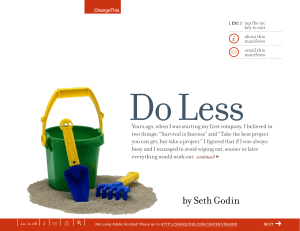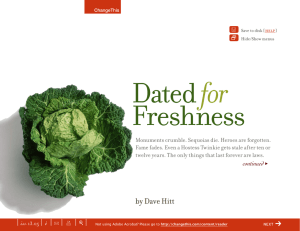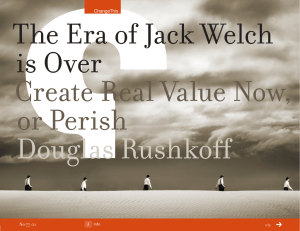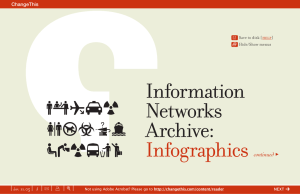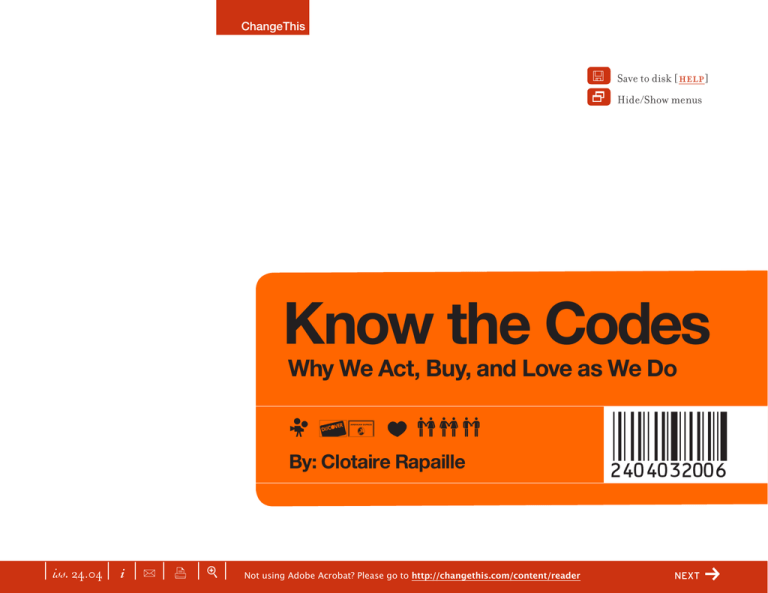
ChangeThis
Y
Save to disk [ help ]
2
Hide/Show menus
Know the Codes
Why We Act, Buy, and Love as We Do
8 WA
acb
By: Clotaire Rapaille
| iss. 24.04 | i | U |
x
|+|
Not using Adobe Acrobat? Please go to http://changethis.com/content/reader
2404032006
next
f
ChangeThis
For Americans, it’s a gallop. For Europeans, it’s a march. For Jeep, it was a breakthrough.
In the late 1990s, the Jeep Wrangler was struggling to regain its place in the American market. Once in a category all its own, it had been supplanted by scores of SUVs, most of which
were bigger, more luxurious, and better suited to soccer moms. Chrysler had reached a
crossroads with the Wrangler and gave serious thought to a major overhaul.
I didn’t ask them what they wanted in a Jeep; I asked
them to tell me about their earliest memories of Jeeps.
When I began working with Chrysler on the Jeep Wrangler in the late 1990s, the company’s
management was understandably suspicious about my approach to learning consumer
preferences. They’d done extensive market research and had asked dozens of focus groups
hundreds of questions. I walked through the door with a bunch of different approaches and
they said to themselves, “What is this guy going to give us that we don’t already have?”
The people at Chrysler had indeed asked hundreds of questions; they just hadn’t asked the
right ones. They kept listening to what people said. This is always a mistake. As a result, they
had theories about moving the Wrangler in multiple directions (more luxurious, more like a
traditional car, without removable doors, enclosed rather than convertible, and so on) with no
clear path to follow. The Wrangler—the classic consumer Jeep—verged on losing its distinctive place in the universe of automobiles, becoming, for all intents and purposes, just another
SUV.
When I put groups of consumers together, I asked them different questions. I didn’t ask them
what they wanted in a Jeep; I asked them to tell me about their earliest memories of Jeeps.
Respondents told me hundreds of stories, and the stories had a strong recurring image—of
| iss. 24.04 | i | U |
x
|+|
h
/17
f
ChangeThis
being out on the open land, of going where no ordinary car could go, of riding free of the
restraints of the road. Many people spoke of the American West or the open plains.
I returned to those wary Chrysler executives and told them that the Code for Jeep in America
is HORSE. Their notion of turning the Wrangler into just another SUV was ill-advised. SUVs are
not horses. Horses don’t have luxury appointments. Horses don’t have buttersoft leather, but
rather the tough leather of a saddle. The Wrangler needed to have removable doors and an
open top because drivers wanted to feel the wind around them, as though they were riding
on a horse.
The executives weren’t particularly moved. After all, they had vast research that told them
consumers said they wanted something else. Maybe people once thought of Jeeps as horses,
but they didn’t want to think of them that way any longer. I asked them to test my theory by
making a relatively minor adjustment to the car’s design: replacing the square headlights with
round ones. Why? Because horses have round eyes, not square ones.
When it turned out that it was cheaper to build the car with round headlights, the decision
became easier for them to make. They tested the new design and the response was instantly
positive. Wrangler sales rose and the new “face” of the Wrangler became its most prominent
and marketable feature. In fact, the car’s logo has incorporated its grille and round headlights ever since. There are even Jeep fan 2 clubs that distribute T-shirts to their members
bearing the legend “Real Jeeps have round headlights.”
Meanwhile, the company began to advertise the car as a “horse.” My favorite ad shows a child
in the mountains with a dog. The dog falls off a cliff and clings precariously to a tree. The
kid runs into a nearby village for help. He passes sedans, minivans, and SUVs until he comes
upon a Jeep Wrangler. The Wrangler scales the treacherous mountain terrain and its driver
rescues the dog. The kid hugs the dog and then turns to thank the driver—but the Jeep is
| iss. 24.04 | i | U |
x
|+|
h
/17
f
ChangeThis
already heading back down the mountain, just like an old Western hero heading off into the
sunset upon his steed. The campaign was a smash.
Bolstered by its American success, Chrysler hired me to discover the Code for the Wrangler in
Europe. Respondents in both France and Germany saw Wranglers as reminiscent of the Jeeps
American troops drove during World War II. For the French, this was the image of freedom
from the Germans. For the Germans, this was the image of freedom from their darker selves.
Repeatedly, the people in these countries told me stories about how the image of a Jeep gave
them a sense of hope, reminding them of the end of difficult times and the dawn of better
days. I returned to Chrysler and told them that the Code for the Jeep Wrangler in both countries was LIBERATOR.
With the news of the Code, Chrysler launched new campaigns in France and Germany. Here,
though, instead of positioning the car as a horse, they stressed the Jeep’s proud past and the
freedom gained from driving a Wrangler. These campaigns were also tremendously successful, expanding market share for the Wrangler in both countries.
By this point, Chrysler’s executives no longer doubted my approach. They’d come to appreciate the power of the Culture Code.
***
For Ritz-Carlton, the revelation came unexpectedly, via…toilet paper. When I began to consult
for this company, I shocked them by telling them that the work they needed to do to improve
customer satisfaction had to begin in the bathroom. Of course they thought I was delirious,
but they heard me out.
If you ask most people why they buy the toilet paper they do, they will say, “Because it is soft
and because it is on sale.” They have no idea that the Code for toilet paper might be anything
but strictly utilitarian. They are wrong. As with Jeep, my work with consumers to crack the
| iss. 24.04 | i | U |
x
|+|
ChangeThis is giving you manifestos like this free of charge. See the rest of them.
h
/17
f
ChangeThis
Code for toilet paper revealed something powerful and unexpected about Americans’ first
imprint of a familiar product.
As with Jeep, my work with consumers to crack the Code
for toilet paper revealed something powerful
and unexpected about Americans’ first imprint
of a familiar product.
For American parents, toilet training is taken very seriously. For some, toilet training is considered so essential that they start the process not long after their child’s first birthday. And,
regardless of when they start, parents support a small industry of books, videos, and even
psychologists who focus on the task. (A current controversy in the field involves the idea of
the “diaper-free” baby, who may be toilet trained as early as eight months old!) Toilet training
has significant social consequences: it affects everything from playdates to car trips to acceptance in preschool. There is also, of course, the stirring sense of liberation that comes when
mothers and fathers realize they no longer need to change diapers.
For the American child himself, however, the completion of toilet training triggers a different
response. Once he can use the toilet by himself—or, more specifically, use the toilet and toilet
paper by himself—a remarkable thing happens. The child can now close the bathroom door,
maybe even lock it, and reject his parents. And, amazingly, he will be praised for doing so.
His parents are proud of him for not needing them anymore. They smile and applaud him.
Sometimes they even buy him presents.
| iss. 24.04 | i | U |
x
|+|
h
/17
f
ChangeThis
This imprint is fully associated with the use of toilet paper rather than the use of the toilet
itself. In the early years, using the toilet still requires a parent to come in—or to sit there with
the child until she is finished—to wipe up afterward. It is only after the child is adept at using
toilet paper that she can be free behind the bathroom door. Free, and without guilt, since she
has the full endorsement of the authority figures in her life.
This imprint is so strong in the American culture that the Culture Code for toilet paper is
INDEPENDENCE.
For Ritz-Carlton, this meant a huge opportunity to cater to their guests in the one room
of the house (or suite) that signifies complete privacy and independence. Why not have a
phone in the bathroom? A notepad and pen to take notes? Why stop there—why not make
the bathroom comfortable, spacious, and independent of the hotel suite? Merely functional,
a bathroom is forgettable. A bathroom that is a fully equipped and independent retreat from
the world, however, is right on Code. Indeed, if you look to the new homes being built in
prosperous neighborhoods today, you will see the same effect. Bathrooms are growing ever
larger, with formerly luxury appointments now standard—sunken bathtubs, double sinks,
televisions, phone jacks, and always, always, a door to lock out the world.
The reason? The Codes.
***
The Culture Code is the unconscious meaning we apply to any given thing—a car, a type of
food, a relationship, even a country—via the culture in which we are raised. The American
experience with Jeeps is very different from the French and German experience because
our cultures evolved differently (we have strong cultural memories of the open frontier; the
French and Germans have strong cultural memories of occupation and war). Therefore, the
Codes—the meanings we give to the Jeep at an unconscious level—are different as well. The
reasons for this are numerous (and I will describe them in the next chapter), but it all comes
| iss. 24.04 | i | U |
x
|+|
h
/17
f
ChangeThis
down to the worlds in which we grew up. It is obvious to everyone that cultures are different
from one another. What most people don’t realize, however, is that these differences actually
lead to our processing the same information in different ways.
The Culture Code is the unconscious meaning
we apply to any given thing—a car, a type of food,
a relationship, even a country—via the culture
in which we are raised.
My journey toward the discovery of cultural codes began in the early 1970s. I was a psychoanalyst in Paris at the time, and my clinical work brought me to the research of the great
scientist Henri Laborit, who drew a clear connection between learning and emotion, showing
that without the latter the former was impossible. The stronger the emotion, the more clearly
an experience is learned. Think of a child told by his parents to avoid a hot pan on a stove.
This concept is abstract to the child until he reaches out, touches the pan, and it burns him.
In this intensely emotional moment of pain, the child learns what “hot” and “burn” mean and
is very unlikely ever to forget it.
The combination of the experience and its accompanying emotion creates something known
widely as an imprint, a term first applied by Konrad Lorenz. Once an imprint occurs, it
strongly conditions our thought processes and shapes our future actions. Each imprint helps
make us more of who we are. The combination of imprints defines us.
| iss. 24.04 | i | U |
x
|+|
What are the most talked about manifestos? Find out here.
h
/17
f
ChangeThis
One of my most memorable personal imprints came when I was a young boy. I grew up in
France, and when I was about four years old, my family received an invitation to a wedding. I’d
never been to one before and I had no idea what to expect. What I encountered was remarkable. French weddings are unlike weddings in any other culture I know. The event went on
for two days, nearly all of which was spent around a large communal table. People stood at
the table to offer toasts. They climbed on the table to sing songs. They slept under the table
and (as I later learned) even seduced one another under the table. Food was always available.
People drank le trou Normand, a glass of Calvados that allowed them to make room for more
food. Others simply went to the bathroom to vomit so they could eat more. It was an amazing
thing for a child to see, and it left a permanent imprint on me. Forevermore, I would associate weddings with gustatory excess. In fact, the first time I went to a wedding in America, I
was taken aback by how sedate it was in comparison. Recently, my wife (who also grew up in
France) and I held the kind of multiday feast that meant “wedding” to both of us.
Every imprint influences us on an unconscious level. When the work of Laborit crystallized
this for me, I began to incorporate what I had learned from him into my clinical work in Paris,
most of which was being done with autistic children (in fact, Laborit led me to the theory that
autistic children do not learn effectively because they lack the emotion to do so). The subject
of imprinting also formed the foundation of the lectures I gave during this time. After one
particular lecture at Geneva University, the father of a student approached me.
“Dr. Rapaille, I might have a client for you,” he said.
Always intrigued at the possibilities offered by another case, I nodded with interest. “An
autistic child?”
“No,” he said, smiling. “Nestlé.”
| iss. 24.04 | i | U |
x
|+|
h
/17
f
ChangeThis
At the time, focused on clinical and scholarly work, I barely understood what the word “marketing” meant. I therefore couldn’t possibly imagine what use I would be to a corporation.
This offer [with Nestlé] was a chance
to quickly test theories I had developed about
imprinting and the unconscious mind.
“Nestlé? What can I do for them?”
“We are trying to sell instant coffee in Japan, but we aren’t having as much success as we
would like. Your work on imprints might be very helpful to us.”
We continued to talk and the man made me an extremely attractive offer. Not only were the
financial terms considerable, but there was something promising about a project like this.
Unlike my work with autistic children, where progress was painfully slow, this offer was a
chance to quickly test theories I had developed about imprinting and the unconscious mind.
This offer [with Nestle] was a chance to quickly test theories I had developed about imprinting
and the unconscious mind. It was an opportunity too good to pass up. I took a sabbatical and
went off on my new assignment.
My first meeting with Nestlé executives and their Japanese advertising agency was very instructive. Their strategy, which today seems absurdly wrong but wasn’t as obviously so in the
1970s, was to try to convince Japanese consumers to switch from tea to coffee. Having spent
some time in Japan, I knew that tea meant a great deal to this culture, but I had no sense of
what emotions they attached to coffee. I decided to gather several groups of people together
| iss. 24.04 | i | U |
x
|+|
h
/17
f
ChangeThis
to discover how they imprinted the beverage. I believed there was a message there that could
open a door for Nestlé.
I structured a three-hour session with each of the groups. In the first hour, I took on the persona of a visitor from another planet, someone who had never seen coffee before and had no
idea how one “used” it. I asked for help understanding the product, believing their descriptions would give me insight into what they thought of it.
In the next hour, I had them sit on the floor like elementary school children and use scissors
and a pile of magazines to make a collage of words about coffee. The goal here was to get
them to tell me stories with these words that would offer me further clues.
In the third hour, I had participants lie on the floor with pillows. There was some hesitation
among members of every group, but I convinced them I wasn’t entirely out of my mind. I put
on soothing music and asked the participants to relax. What I was doing was calming their
active brainwaves, getting them to that tranquil point just before sleep. When they reached
this state, I took them on a journey back from their adulthood, past their teenage years, to a
time when they were very young. Once they arrived, I asked them to think again about coffee
and to recall their earliest memory of it, the first time they consciously experienced it, and
their most significant memory of it (if that memory was a different one).
I designed this process to bring participants back to their first imprint of coffee and the emotion attached to it. In most cases, though, the journey led nowhere. What this signified for
Nestlé was very clear.
While the Japanese had an extremely strong emotional connection to tea (something I learned
without asking in the first hour of the sessions), they had, at the most, a very superficial
imprint of coffee. Most, in fact, had no imprint of coffee at all.
| iss. 24.04 | i | U |
x
|+|
Want to copy and paste parts of this manifesto? Click here for instructions.
h
10/17
f
ChangeThis
Under these circumstances, Nestlé’s strategy of getting these consumers to switch from tea to
coffee could only fail. Coffee could not compete with tea in the Japanese culture if it had such
weak emotional resonance. Instead, if Nestlé was going to have any success in this market at
all, they needed to start at the beginning. They needed to give the product meaning in this
culture. They needed to create an imprint for coffee for the Japanese.
If I could somehow “decode” elements of culture to
discover the emotions and meanings attached to them
I would learn a great deal about human behavior.
Armed with this information, Nestlé devised a new strategy. Rather than selling instant coffee to a country dedicated to tea, they created desserts for children infused with the flavor
of coffee but without the caffeine. The younger generation embraced these desserts. Their
first imprint of coffee was a very positive one, one they would carry throughout their lives.
Through this, Nestlé gained a meaningful foothold in the Japanese market. While no marketer
will likely ever be able to convince the Japanese to abandon tea, coffee sales—nearly nonexistent in 1970—now approach half a billion pounds per year in Japan. Understanding the
process of imprinting—and how it related directly to Nestlé’s marketing efforts—unlocked a
door to the Japanese culture for them and turned around a floundering business venture.
It did something much more important for me, however. The realization that there was no
significant imprint for coffee in Japan underscored for me that early imprinting has a tremendous impact on why people do what they do. In addition, the fact that the Japanese did
not have a strong imprint for coffee while the Swiss (Nestlé is a Swiss company) obviously
| iss. 24.04 | i | U |
x
|+|
h
11/17
f
ChangeThis
did made it clear that imprints vary from culture to culture. If I could get to the source of
these imprints—if I could somehow “decode” elements of culture to discover the emotions
and meanings attached to them—I would learn a great deal about human behavior and how
it varies across the planet. This set me on the course of my life’s work. I went off in search of
the Codes hidden within the unconscious of every culture.
***
When a man and a woman have a child, they have a little human being rather than a bird, a
fish, or an alligator. Their genetic code dictates this. When an American man and an American
woman have a child, they have a little American. The reason for this is not genetic; it is because a different code—the Culture Code—is at work.
For example, “the sun” in French is le soleil, a masculine noun, and, for the French, a word
closely associated with the Sun King, Louis XIV. The French, who imprint this reference at
a young age, perceive the sun as male and, by extension, see males as brilliant and shining. Women, on the other hand, are associated with the moon, la lune, a feminine word. The
moon, of course, does not shine by herself; she reflects the light of the sun. We can learn
much about the relationship between French men and French women through this observation and the understanding of how French children receive the imprint of these terms.
For Germans, however, these words have nearly opposite meanings. The sun, die Sonne, is
feminine, and Germans believe that women are the ones who bring warmth to the world,
make things grow, and raise children. German men are the night, the dark, the moon side.
Der Mond, “the moon,” is a masculine term. Again, this speaks volumes about the relationships the genders have to each other in this culture and the roles they play in this society.
The simple acquisition of words like “sun” and “moon” can trigger completely opposite
imprints among the French and Germans. Therefore, each culture has a different interpretation—a different Code—for these words. All of the different codes for all of the different
| iss. 24.04 | i | U |
x
|+|
h
12/17
f
ChangeThis
imprints, when put together, create a reference system that people living in these cultures
use without being aware of it. These reference systems guide different cultures in very different ways.
An imprint and its Code are like a lock and its combination. If you have all of the right numbers in the right sequence, you can open the lock. Doing so over a vast array of imprints has
There is remarkable freedom gained in
understanding why you act the way you do.
profound implications. It brings us to the answer to one of our most fundamental questions:
why do we act the way we do? Understanding the Culture Code provides us with a remarkable
new tool—a new set of glasses, if you will, with which to view ourselves and our behaviors. It
changes the way we see everything around us. What’s more, it confirms what we have always
suspected is true—that, despite our common humanity, people around the world really are
different. The Culture Code offers a way to understand how.
I have more than three decades of experience decoding imprints for major corporations
around the world. I call this decoding process a “discovery”—I have performed more than
three hundred—and I have seen these discoveries put to work to my clients’ advantage. More
than half of today’s Fortune 100 companies have me on retainer, and corporate response to
my findings has validated the accuracy of my work, assuring me that the glasses I have fashioned, the glasses of the Culture Code, offer a new and especially vivid vision of the world
around us. Over the last thirty years, I have devised and patented a proven, tested method
for making discoveries. In my book, The Culture Code, I share this method, and some of what
I have learned about major world cultures by using it.
| iss. 24.04 | i | U |
x
|+|
Want to find the most buzzworthy manifestos? discover them here.
h
13/17
f
ChangeThis
My primary intent is to liberate those who read my book. There is remarkable freedom
gained in understanding why you act the way you do. This freedom will affect every part of
your life, from the relationships you have, to your feelings about your possessions and the
things you do, to the attitudes you have about America’s place in the world.
The topics I discuss in my book include many of the most significant forces driving our lives:
sex, money, relationships, food, fat, health, and even America itself. You will see how participants in the discovery sessions led me to the Codes and how the revelation of the Codes
led me to a new understanding of behavior in this country, how it contrasts with behavior in
other cultures, and what these differences mean for all of us.
Once you know the Codes, nothing will ever look the same again.
| iss. 24.04 | i | U |
x
|+|
h
14/17
f
ChangeThis
info
About the Author
Dr. Clotaire Rapaille is the chairman of Archetype Discoveries Worldwide. He is the personal adviser to
ten high-ranking CEOs and is kept on retainer by fifty Fortune 100 companies. Dr. Rapaille’s unique
approach to marketing combines a psychiatrist’s depth of analysis with a businessman’s attention to
practical concerns. His technique for market research has grown out of his work in the areas of psy-
chiatry, psychology, and cultural anthropology. He has been profiled in many national media outlets,
including 60 Minutes II and on the front page of the New York Times Sunday Styles section.
This manifesto is excerpted from Dr. Rapaille’s book, The Culture Code: Why People Around the World are
Different, And the Hidden Clues to Understanding Us All. http://archetypediscoveriesworldwide.com/
download this
This manifesto is available from http://changethis.com/24.KnowTheCodes
send this Click here to pass along a copy of this manifesto to others.
http://changethis.com/24.KnowTheCodes/email
Subscribe
Learn about our latest manifestos as soon as they are available. Sign up for our free newsletter and
be notified by email. http://changethis.com/subscribe
z
| iss. 24.04 | i | U |
x
|+|
last page read
h
| more
15/17
f
f
ChangeThis
info
WHAT YOU CAN DO
You are given the unlimited right to print this manifesto and to distribute it electronically (via email,
your website, or any other means). You can print out pages and put them in your favorite coffee shop’s
windows or your doctor’s waiting room. You can transcribe the author’s words onto the sidewalk, or
you can hand out copies to everyone you meet. You may not alter this manifesto in any way, though,
and you may not charge for it.
Navigation & User Tips Move around this manifesto by using your keyboard arrow keys or click on the right arrow ( f ) for
the next page and the left arrow ( h ). To send this by email, just click on
U
.
Having problems saving to disk? First, make sure you have the latest version of Acrobat Reader 6 which you can download from
http://www.adobe.com/products/acrobat/readstep2.html. If problems persist, it may be due to your
Acrobat Reader settings. To correct the problem (for Windows), a reader, J. Hansen, suggests going
to your Acrobat Reader Preferences > Options > Web browser Options. Check the “Display PDF in
Browser” option. Then click on Save to Disk
Y
.
keyboard shortcuts
pc
mac
Zoom in (Larger view)
[ ctl ] [ + ] [
Full screen/Normal screen view
[ ctl ] [ L ] Zoom out
#]
[#]
[#]
[ ctl ] [ - ] z
| iss. 24.04 | i | U |
x
|+|
[+]
[-]
[L]
last page read
h
| more
16/17
f
f
ChangeThis
info
Born on date
This document was created on 3 July 2006 and is based on the best information available at that
time. To check for updates, please click here to visit http://changethis.com/24.KnowTheCodes
Copyright info
some rights reserved
cc creative
commons
The copyright in this work belongs to the author, who is solely responsible for the content. Please
direct content feedback or permissions questions to the author.
This work is licensed under the Creative Commons Attribution-NonCommercial-NoDerivs License.
To view a copy of this license, visit http://creativecommons.org/licenses/by-nc-nd/2.5 or send a
letter to Creative Commons, 559 Nathan Abbott Way, Stanford, California 94305, USA.
ABOUT CHANGETHIS
ChangeThis is a vehicle, not a publisher. We make it easy for big ideas to spread. While the authors
we work with are responsible for their own work, they don’t necessarily agree with everything
available in ChangeThis format. But you knew that already.
ChangeThis is supported by the love and tender care of 800-CEO-READ. Visit us at main site
www.800ceoread.com or at our daily blog blog.800ceoread.com.
z
| iss. 24.04 | i | U |
x
|+|
last page read
h
17/17



